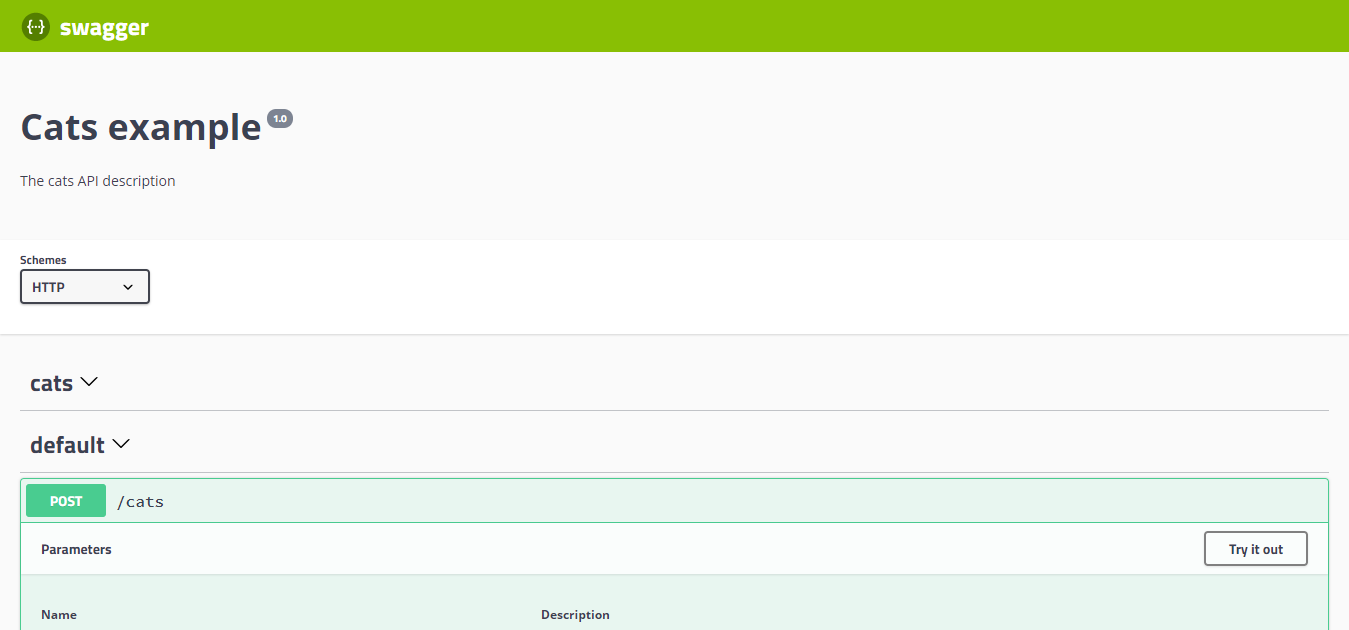Introduction
The OpenAPI specification is a language-agnostic definition format used to describe RESTful APIs. Nest provides a dedicated module which allows generating such a specification by leveraging decorators.
Installation
To begin using it, we first install the required dependency.
$ npm install --save @nestjs/swagger
Bootstrap
Once the installation process is complete, open the main.ts file and initialize Swagger using the SwaggerModule class:
@@filename(main)
import { NestFactory } from '@nestjs/core';
import { SwaggerModule, DocumentBuilder } from '@nestjs/swagger';
import { AppModule } from './app.module';
async function bootstrap() {
const app = await NestFactory.create(AppModule);
const config = new DocumentBuilder()
.setTitle('Cats example')
.setDescription('The cats API description')
.setVersion('1.0')
.addTag('cats')
.build();
const document = SwaggerModule.createDocument(app, config);
SwaggerModule.setup('api', app, document);
await app.listen(3000);
}
bootstrap();
info Hint
document(returned by theSwaggerModule#createDocument()method) is a serializable object conforming to OpenAPI Document. Instead of hosting it via HTTP, you could also save it as a JSON/YAML file, and consume it in different ways.
The DocumentBuilder helps to structure a base document that conforms to the OpenAPI Specification. It provides several methods that allow setting such properties as title, description, version, etc. In order to create a full document (with all HTTP routes defined) we use the createDocument() method of the SwaggerModule class. This method takes two arguments, an application instance and a Swagger options object. Alternatively, we can provide a third argument, which should be of type SwaggerDocumentOptions. More on this in the Document options section.
Once we create a document, we can call the setup() method. It accepts:
- The path to mount the Swagger UI
- An application instance
- The document object instantiated above
- Optional configuration parameter (read more here)
Now you can run the following command to start the HTTP server:
$ npm run start
While the application is running, open your browser and navigate to http://localhost:3000/api. You should see the Swagger UI.

As you can see, the SwaggerModule automatically reflects all of your endpoints.
info Hint To generate and download a Swagger JSON file, navigate to
http://localhost:3000/api-json(assuming that your Swagger documentation is available underhttp://localhost:3000/api). It is also possible to expose it on a route of your choice using only the setup method from@nestjs/swagger, like this:SwaggerModule.setup('swagger', app, document, {
jsonDocumentUrl: 'swagger/json',
});Which would expose it at
http://localhost:3000/swagger/json
warning Warning When using
fastifyandhelmet, there may be a problem with CSP, to solve this collision, configure the CSP as shown below:app.register(helmet, {
contentSecurityPolicy: {
directives: {
defaultSrc: [`'self'`],
styleSrc: [`'self'`, `'unsafe-inline'`],
imgSrc: [`'self'`, 'data:', 'validator.swagger.io'],
scriptSrc: [`'self'`, `https: 'unsafe-inline'`],
},
},
});
// If you are not going to use CSP at all, you can use this:
app.register(helmet, {
contentSecurityPolicy: false,
});
Document options
When creating a document, it is possible to provide some extra options to fine tune the library's behavior. These options should be of type SwaggerDocumentOptions, which can be the following:
export interface SwaggerDocumentOptions {
/**
* List of modules to include in the specification
*/
include?: Function[];
/**
* Additional, extra models that should be inspected and included in the specification
*/
extraModels?: Function[];
/**
* If `true`, swagger will ignore the global prefix set through `setGlobalPrefix()` method
*/
ignoreGlobalPrefix?: boolean;
/**
* If `true`, swagger will also load routes from the modules imported by `include` modules
*/
deepScanRoutes?: boolean;
/**
* Custom operationIdFactory that will be used to generate the `operationId`
* based on the `controllerKey` and `methodKey`
* @default () => controllerKey_methodKey
*/
operationIdFactory?: (controllerKey: string, methodKey: string) => string;
}
For example, if you want to make sure that the library generates operation names like createUser instead of UserController_createUser, you can set the following:
const options: SwaggerDocumentOptions = {
operationIdFactory: (
controllerKey: string,
methodKey: string
) => methodKey
};
const document = SwaggerModule.createDocument(app, config, options);
Setup options
You can configure Swagger UI by passing the options object which fulfills the SwaggerCustomOptions interface as a fourth argument of the SwaggerModule#setup method.
export interface SwaggerCustomOptions {
/**
* If `true`, Swagger resources paths will be prefixed by the global prefix set through `setGlobalPrefix()`.
* Default: `false`.
* @see https://docs.nestjs.com/faq/global-prefix
*/
useGlobalPrefix?: boolean;
/**
* If `false`, only API definitions (JSON and YAML) will be served (on `/{path}-json` and `/{path}-yaml`).
* This is particularly useful if you are already hosting a Swagger UI somewhere else and just want to serve API definitions.
* Default: `true`.
*/
swaggerUiEnabled?: boolean;
/**
* Url point the API definition to load in Swagger UI.
*/
swaggerUrl?: string;
/**
* Path of the JSON API definition to serve.
* Default: `<path>-json`.
*/
jsonDocumentUrl?: string;
/**
* Path of the YAML API definition to serve.
* Default: `<path>-yaml`.
*/
yamlDocumentUrl?: string;
/**
* Hook allowing to alter the OpenAPI document before being served.
* It's called after the document is generated and before it is served as JSON & YAML.
*/
patchDocumentOnRequest?: <TRequest = any, TResponse = any>(
req: TRequest,
res: TResponse,
document: OpenAPIObject
) => OpenAPIObject;
/**
* If `true`, the selector of OpenAPI definitions is displayed in the Swagger UI interface.
* Default: `false`.
*/
explorer?: boolean;
/**
* Additional Swagger UI options
*/
swaggerOptions?: SwaggerUiOptions;
/**
* Custom CSS styles to inject in Swagger UI page.
*/
customCss?: string;
/**
* URL(s) of a custom CSS stylesheet to load in Swagger UI page.
*/
customCssUrl?: string | string[];
/**
* URL(s) of custom JavaScript files to load in Swagger UI page.
*/
customJs?: string | string[];
/**
* Custom JavaScript scripts to load in Swagger UI page.
*/
customJsStr?: string | string[];
/**
* Custom favicon for Swagger UI page.
*/
customfavIcon?: string;
/**
* Custom title for Swagger UI page.
*/
customSiteTitle?: string;
/**
* File system path (ex: ./node_modules/swagger-ui-dist) containing static Swagger UI assets.
*/
customSwaggerUiPath?: string;
/**
* @deprecated This property has no effect.
*/
validatorUrl?: string;
/**
* @deprecated This property has no effect.
*/
url?: string;
/**
* @deprecated This property has no effect.
*/
urls?: Record<'url' | 'name', string>[];
}
Example
A working example is available here.